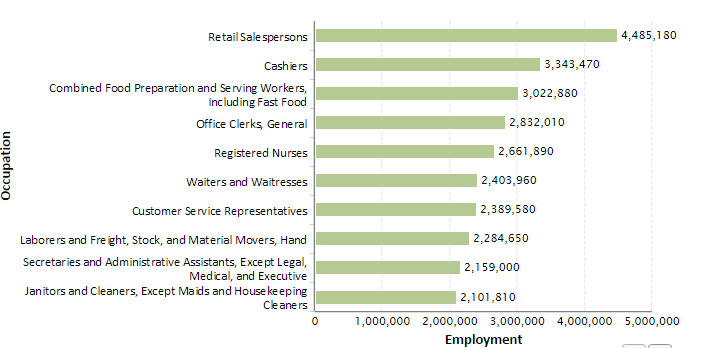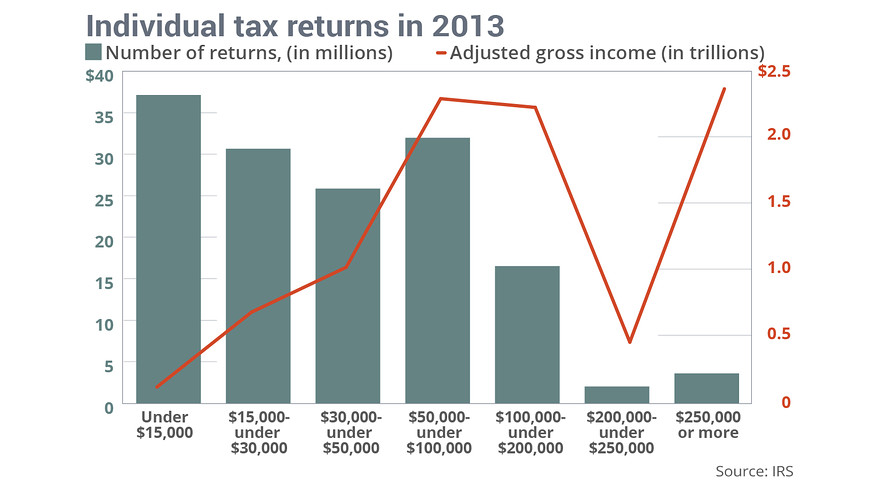Top 4 largest occupation sectors in the United States all in the low wage service sector paying $10 an hour or less: What does it mean living near the minimum wage?
- 6 Comment
People have a hard time wrapping their minds around the economic fact that the top employment sectors in the United States are all made up of occupations in the low wage service sector. We define low wage as a job that pays $10 an hour or less. The press doesn’t really highlight this working poor segment of our society even though a large percentage of our population is employed in an industry that pays very little and offers scant benefits (if any). There was a time when the top employment sectors in the US involved people making things and wages provided enough for a healthy standard of living. Now most Americans need to go into incredible levels of debt to purchase homes or even go to college. I always find it useful to look at the top employment sectors in our country because it gives us a good sense as to what jobs are dominating the market. Let us take a look at some of the top employment fields.
Low wage employment
It may be a surprise to you that the job with the most workers is that of retail salesperson. Over 4.4 million Americans are employed in this job category. This job pays very little but also carries almost no benefits. Then we wonder why many of the 46 million Americans on food stamps actually have jobs.
But let us look at the top fields more carefully:
Source:Â BLS
The top 4 employment sectors are:
-Retail salesperson with 4,485,180 employed
-Cashiers with 3,343,470 employed
-Food prep and service workers with 3,022,880
-Office clerks with 2,832,010
Over 13 million Americans are employed in these four industries alone that pay very low wages. These are the top jobs in our country. The next top field is nursing which does pay a good wage but requires people to go to college. Many public schools that offer nursing programs are heavily impacted many with waiting lists that go on for years. Private schools are there and of course, but tuition is soaring beyond wage growth so many are forced with choosing between a life of minimum wage or going into debt to finance their education.
Following nursing, the next top employment sector is waiters and waitresses. This is another sector that pays little and offers virtually no benefits. Next? Customer service reps. In fact, out of the top 10 employment sectors in the US only one pays what many would consider a livable wage.
We covered income data in a previous post and some had a hard time understanding why the tax bracket with the largest raw number of people are those making $15,000 or less:
“As it turns out, the largest tax bracket comes in the form of those making $15,000 or less per year (this group makes up 25% of tax filings).â€
There is a reason why there are tens of thousands of dollar stores selling items that are largely made outside of the US. Many older Americans, a growing segment of our society, are living day-to-day only because of Social Security. In fact, without Social Security many would be out in the streets living a life of financial destitution.
I’m not sure if we are going to see this trend reverse anytime soon. Certainly the political theme for 2016 is going to be economic. The focus will be on wages and the middle class. But as you can see from the data above, a large portion of our society has been demoted from the middle class into a large low wage economy where debt is a necessity to move forward.
If you enjoyed this post click here to subscribe to a complete feed and stay up to date with today’s challenging market!6 Comments on this post
Trackbacks
-
SRV said:
And of course the (mostly) RW politicos demonize the ‘takers’ working for peanuts, while they collude to enact policies that benefit those at the top.
And the most nefarious aspect is the captured media that ‘parrots’ the taker meme, convincing so many ‘on deck’ for the same treatment… work harder for less, and qualify for social benefits, which of course are nothing but “free stuff” for the corporations who get away slave wages while millions of dolts cheer them on!
What a wonderful world…
February 14th, 2015 at 2:15 pm -
andrew james said:
Food preparation is the new manufacturing sector.
February 15th, 2015 at 12:28 am -
Ulysses said:
It is interesting that all the “low” wage jobs listed are non-manufacturing.
To put things into perspective, back in 1970 a Big Mac and a gallon of gas were both 25c and a typical middle-class job paid $6/hr. Focusing on the wage figure alone without considering either its purchasing power or the worth of the work done is both misleading and meaningless.
It is also interesting that while the “minimum wage” proponents demand the employers to pay a wage regardless of the worth of the work, nobody has demanded either a “minimum worth” from the workers or a “maximum price” regardless of the worth of the product.
No wonder, minimum wage has historically been a treadmill.
February 15th, 2015 at 7:55 am -
James Hammers said:
All we ever see in the news is that wages are an expense that impacts the profit margin, which seems to be the prime indicator of success and if one increases wage intact the employer must raise prices to offset the impact on profit. However these same people invest in research and in a lot of advertising, money that comes from current or unrealized profits in the belief that research and advertising are more of an asset than an expense in a belief that they will result in an increase in future sales that will will increase sales enough to offset current expenses. Thus, while research and advertising are a current expense, they are more of an asset than an expense. What if wages were also seen as more of an asset than an expense. Profits arise from the sale of the products and services offered. People are paid a wages to produce those goods and services but those people, in turn, earn wages to spend them on those goods and services they and their dependents need to live, hopefully, to enjoy at least a basic standard of living, to be able to provide for themselves and their dependents the basics such as food, shelter, clothing, medical care, education. But they cannot spend what they do not have unless they go into debt which puts and additional burden on their limited finances.
We, the people, have been trying to supplement low wages or the lack of them through various programs, such as food stamps, rent subsidies, free education, and more. These funds are supposedly covered by taxes but with all the tax breaks and exemptions available not enough taxes are collected forcing us to either go into debt, resulting in huge debts in both the national and state coffers, or discontinue or restrict programs.
What if the private sector would realize that wages are more of an asset than an expense, an asset that would realize a tremendous jump in sales and more than justify the expense of research, advertising and wages. Over 50% of current wage earners and an additional roughly 10% who would like to work but cannot find a job, a total of 60% can barely, or not at all, provide for themselves but would love to be able to buy what they need and even beyond needs if they could. Increasing wages to at least to a level that would make a basic standard of living possible would immediately cause a 50& increase spending boom for the goods and services needed food, shelter, clothing etc.. With the increase in demand, jobs paying enough for a basic standard of living would have to be created to meet the demand and those currently out of work could find good paying jobs increasing the spending boom another 10%. With a healthy customer base at the basic level would increase the pressure for jobs that pay beyond the basic standard of living. And the economy is on its road to recovery.
Thus our recovery is dependent upon an ever improving customer base which improves with increasing wages, seen as more of an asset than an expense. Like a body riddled with cancer and being able to function only with great difficulty, which, with proper care, rids itself of cancer, can function again with renewed health and vigor. our economy can recover with a the proper care to our customer base restoring it to health and vigor through wages able to prove their worth more as an asset than an expense.February 15th, 2015 at 9:49 am -
Steven said:
Basically all that a man must pay to live and raise a family must come from his income and that either comes from an employer or from investments. Since the biggest expense is a roof over ones head the minimum wage for a man should be the house price divided by equal to or less than 6000 man hours. That is the maximum one should pay for a home and the minimum one should be paid per hour.
Either wage rates are correct and real estate prices are out of line or real estate prices are correct and wage rates are out of line as in inadequate. How ever as things stand now wage rates and real estate prices can not both be right. Everything a man must spend must come from income therefore expenses must be at some reasonable ratio to that income or a man and his family will not be able to live properly and the results will be deprivation of the necessities of life and low birthrates which is by definition genocide.
The implications for employers and greedy real estate market participants is obvious. Criminal liability.February 17th, 2015 at 7:40 am -
stan said:
Many of those in the $10 an hour group were the very same people who laughed and picked on the kids who studied in high school so maybe its poetic justice…
February 20th, 2015 at 1:28 pm


 If you enjoyed this post click here to subscribe to a complete feed and stay up to date with today’s challenging market!Â
If you enjoyed this post click here to subscribe to a complete feed and stay up to date with today’s challenging market!Â